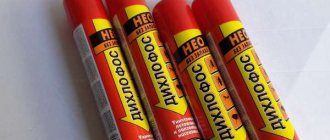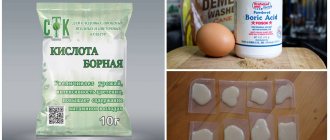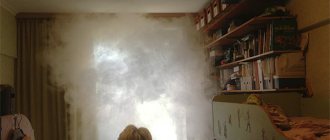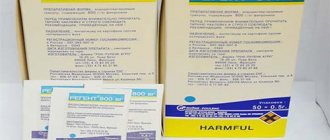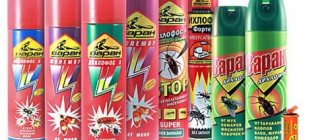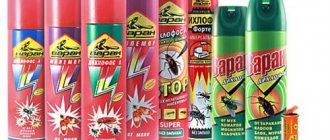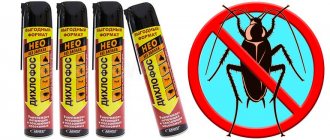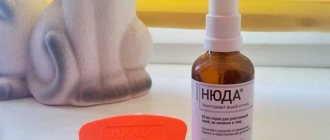A little history
The formula for the toxic substance was developed in the middle of the last century in the USSR. It is based on dimethyl dichlorovinyl phosphate, a powerful insecticide with nerve paralytic action. The product was produced in aerosol cans and emitted a sharp, specific odor.
Before the advent of the first insecticides, it was necessary to poison insects with kerosene and turpentine, so Dichlorvos quickly gained popularity. The aerosol had powerful poisonous properties that affected not only pests, but also people. To use it without harm to health, strict safety rules were required.
Use of Dichlorvos against bedbugs. Instructions
Dichlorvos will be effective in killing bedbugs if it is used strictly in accordance with the manufacturer's instructions.
Attention!
Dichlorvos is a toxic agent.
All recommendations and instructions must be followed carefully:
- For greater efficiency, it is advisable to find a den of bedbugs, of which there may be several. Spraying should be done directly at and near the epicenter.
- You should also treat the most likely places where small ghouls will appear (cabinets, places under linoleum, etc.)
- All windows and doors should be closed prior to treatment and should not be opened for a sufficient period of time. This is necessary so that the insects are fully saturated with poison.
- The aerosol is sprayed by briefly pressing the corresponding button.
- The can should be held at arm's length so that it is at a sufficient distance from the concentration of the toxic substance.
- Follow safety precautions for working with toxic substances. Wash your hands thoroughly with soap after using Dichlorvos.
Attention!
Clothes are processed in a different way. Those. There is no need to spray poison on clothes.
- Upon completion of the event, you should leave the premises for at least 3-4 hours.
Attention!
Ventilation of the room should be done closer to night.
It is much more effective to ventilate no earlier than every other day.
Composition and varieties of modern Dichlorvos
Over the course of half a century, the formula has undergone dramatic changes. Now dimethyl dichlorovinyl phosphate has been replaced from the composition by modern insecticides, which have a gentle effect on humans and the environment, but are harmful to insects.
On the shelves of hardware stores there is a wide selection of aerosols under the Dichlorvos brand. They are available in iron aerosol cans with a capacity of 300 and 500 ml. Thanks to the fine spray, this amount is enough to treat a two-room apartment with an area of 50 square meters. m.
The following lines are very popular:
- Neo;
- Varan;
- Taiga;
- Clean house;
- Super.
The active ingredients of the drugs are cypermethrin and permethrin, which are second-generation pyrethroids, and piperonyl butoxide, a synergist that increases the toxic properties of insecticides.
Modern Dichlorvos includes additional components that eliminate the unpleasant odor of toxic substances. Fragrances create the aroma of lavender, pine needles, and wildflowers. If desired, you can purchase a product that is completely odorless.
Chemical composition of the product
The first "Dichlorvos" appeared on store shelves more than 30 years ago, and its basis was dimethyl dichlorovinyl phosphate. It did an excellent job of killing insect pests, but the toxic effect on humans and pets was too significant.
This made its use in residential premises a very dangerous undertaking, and the stinking smell after it had to be aired out for quite a long time.
Modern insecticides produced under this brand are no worse at poisoning cockroaches, but thanks to completely different active substances, their toxicity is several times less. Almost all of them are based on the action of synthetic pyrethroids - artificially created analogues of natural pyrethrins.
Often in the composition of modern products you can also find inexpensive and effective cypermethrin, piperonyl butoxide, permethrin, flavors, stabilizers, preservatives and various fragrances.
Important: despite the fact that many types of Dichlorvos are now produced either completely odorless or with a pleasant aroma, remember - this is achieved by adding fragrances, and not reducing the insecticide, and you should behave with extreme caution with them.
Effect on cockroaches
Cypermethrin and permethrin easily penetrate pests through the respiratory tract and chitinous shell. Toxic substances block the passage of nerve impulses, cause suffocation, impaired motor reflexes and rapid death of the insect.
The insecticidal activity of the drug lasts 15 days. A cockroach, running over the treated surface, stains its paws with microscopic particles of poison. They penetrate inside the insect's shell, causing poisoning.
A day later, the room is wet cleaned.
Maximum effectiveness is observed with direct impact on cockroaches. Strong individuals who have inhaled a small percentage of toxic fumes can survive if they have free access to water.
The insecticide eliminates adult cockroaches and larvae - nymphs. He is not able to penetrate the ootheca - the storage of eggs. To eliminate young growth, repeated treatment after half a month is recommended.
Safety regulations
When purchasing Dichlorvos for cockroaches, odorless or with an aromatic fragrance, do not forget about its toxicity. Any form of release of the drug belongs to class 3 hazardous substances and requires caution when used.
During the disinfestation process, follow the safety rules for working with toxic substances:
- Put tight rubber gloves on your hands;
- Protect your respiratory tract with a respirator;
- Protect your eyesight with glasses.
Wear waterproof clothing on your body. You can purchase a special rubberized protective suit.
Before treatment, be sure to remove pets and family members from the apartment. The drug has a serious toxic effect on fish, ornamental birds, and cats.
Pack food items in plastic bags or airtight containers and place them in the refrigerator. Take the dishes out onto the balcony. It is important that she does not come into contact with Dichlorvos vapors.
Instructions
Close the windows and doors in the apartment. Dry the sink, shower stall and bathtub. Place plastic plugs on the sockets. Inspect the room, paying special attention to:
- skirting boards;
- cracks in the walls;
- gas stove;
- the area behind the refrigerator and behind the radiator;
- food cabinets;
- bathroom.
In these places, cockroaches make nests, so they gather in large numbers. Having found a cluster of colonies, spray the cockroaches generously and destroy the dense brown capsules with eggs.
- Move furniture to the middle of the room. Take the can in your hand, shake and treat the room at a distance of 20 cm from the surface, slowly moving from one corner to another.
- Spray drain pipes, door frames, baseboards, walls and furniture.
- Clean the ventilation hole thoroughly. After disinfestation, the Prussians, fleeing from the poison, escape to their neighbors through the ventilation shaft. To prevent migration, place a trap inside or cover the hole with film.
Approximate consumption of product per 1 sq. m – 3 ml. When treating soft surfaces and wooden furniture, double the spray intensity. Dichlorvos does not spoil the upholstery of sofas and does not leave stains on things.
Insect killer Dichlorvos Neo 190 ml
Means for killing all types of insects Dichlorvos Neo
Purpose:
An indispensable universal remedy for the fight against all types of household insects.
Destroys flies, mosquitoes, cockroaches, ants, moths, bedbugs, fleas and other insects. Has no smell. Creates a protective barrier on treated surfaces that lasts up to 2 weeks. Modern Dichlorvos contains a combination of three modern active ingredients, enhanced with a special synergist substance. Leaves insects no chance to survive. Directions for use:
Before use, shake the can well and remove the cap.
To destroy flying insects (flies, mosquitoes, mosquitoes, moths, wasps), close windows and doors, direct a stream of aerosol into the air at the insects, moving from the middle of the room towards the door. Spray at a distance of 1 m from walls and furniture. The application rate is 5-6 seconds of spraying in a room of 12 m2 (volume 30 m3). To kill a wasp that has flown into a room, spray the product directly onto the insect for 2-3 seconds. To destroy moths in wardrobes, spray the product for 2 s per 2 m3 of wardrobe volume. Do not process clothes! To destroy flightless insects from a distance of 20-30 cm, use a jet of aerosol to treat places where insects accumulate and enter the room. Consumption rate is 20 g/m2 of the surface to be treated, which corresponds to 20 seconds of spraying. Should be treated to kill: cockroaches - cracks along baseboards and behind door frames, sewer pipes, around sinks, the back of furniture, floors and walls behind the stove and refrigerator; bed bugs - beds, sofas, cracks in the walls (do not treat bedding!); fleas - cracks behind baseboards and walls to a height of 1 m, bedding for pets, which must be washed before use; skin beetles - places of accumulation and movement; ants - places of movement of insects (“paths”); landing sites for flies - lampshades, door jambs, frames. Precautionary measures:
Protect from direct sunlight and heat above +50°C.
Remove food and utensils during processing! Spray in the absence of people and other living organisms, remove aquariums! Do not spray near open flames or hot objects! Avoid contact with synthetic and varnished objects. Treatment against flightless insects should be carried out with open windows or vents, and against flying insects - with closed ones. After treatment, ventilate the room for 30 minutes with a through air flow and wet clean surfaces that may come into contact with people or food products. Avoid contact with eyes and skin. In case of contact with eyes, rinse with plenty of water; on skin, wash with soap and water! Composition:
Cypermethrin 0.2%, permethrin 0.2%, tetramethrin 0.2%, dimethyl sulfoxide, piperonyl butoxide 1.0%; <5%: corrosion inhibitor; >30%: aliphatic hydrocarbons (propane, butane, isobutane), isopropyl alcohol.
Cleaning
After completing the disinsection, leave the room for 5-6 hours, or better yet, for a day. When you return, open the windows and ventilate your home for half an hour. Fill a bucket with hot water, dissolve 5 tablespoons of baking soda and the same amount of laundry soap shavings. Neutralize the poison by washing the floors, stove, and food cabinets.
In hard-to-reach places, it is better not to clean for half a month in order to preserve the insecticidal activity of Dichlorvos.
After the floor is dry, the apartment becomes safe. Return pets and family members there, remove dishes from the balcony, wash them and put them back.
Instructions for use
To achieve maximum efficiency when treating with Dichlorvos, it is important to follow a certain algorithm.
Insects prefer to settle in secluded places, which they leave only to feed.
Therefore, it is important to prepare the room for disinfestation:
- furniture is moved away from the walls, freeing up access to corners and baseboards;
- cabinets are emptied;
- upholstered furniture is disassembled so that it can be processed from all sides;
- hygiene items, personal belongings, dishes are placed in sealed packages or taken out of the premises;
- paintings and carpets, if any, are removed from the walls;
- Wallpaper that has bubbled up or has come off the walls is torn off.
Clothes, curtains and bed linen must be washed at high temperatures. Before disinsection begins, the room is wet cleaned, paying special attention to corners, baseboards and other closed areas.
Disinsection is carried out with windows and doors closed to maintain the highest possible level of toxic substances in the air. The aerosol is sprayed, holding the can 15-20 cm from the surfaces.
Places that are “attractive” to bedbugs are treated with special care:
- baseboards and cracks along them;
- door and window slopes, window sills (especially below);
- places behind batteries;
- walls, paying attention to the corners and joints of the wallpaper;
- furniture inside and out, especially carefully spraying joints and fittings;
- carpets, sofa cushions and mattresses are processed on both sides;
- upholstered furniture and beds - inside and outside.
After disinfestation, leave the room and leave it closed for at least 30 minutes, and preferably for several hours. Then it is ventilated and wiped with a soap solution on surfaces that are often touched by people. It is better not to wipe closed areas such as back walls and furniture frames, baseboards and corners in order to preserve the protective film. If the level of infection is high, repeated disinsection may be necessary, which is carried out no earlier than after a week.
Review of reviews about Dichlorvos
People highly rate aerosol insecticides and leave good reviews about Dichlorvos for cockroaches. Users confirm that the poisoning ability is maximally manifested when treating pest nests and advise combining disinfestation with the drug using traps, poisonous gels and crayons.
Yulia from the Ryazan region shared her experience of using Dichlorvos in a two-room apartment:
“Last year, cockroaches came in from the neighbors. The hardware store recommended Dichlorvos Varan, odorless. I sprayed the product in places where Prussians gathered, furniture in the kitchen and rooms, cracks under the windowsill, in the bathroom and left for a day. When I returned, I found the corpses of pests right on the floor. In order not to leave the parasites the slightest chance, after cleaning I applied an insecticidal gel to the baseboards. I can say that the disinfestation lived up to expectations. The Prussians disappeared and do not appear again."
Feedback from people leaves no doubt that if the instructions are followed, Dichlorvos shows good results and reliably protects the house from cockroach invasion.
